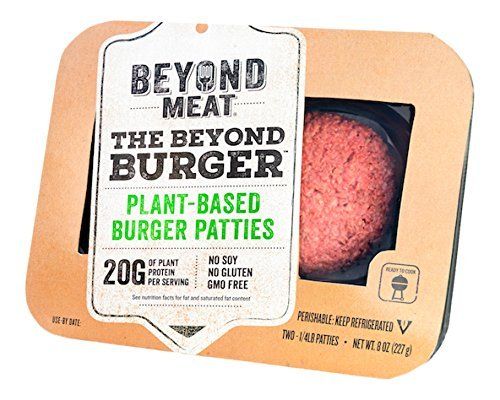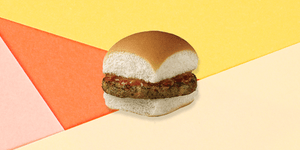Beyond Burgers Are Not Healthier Than Beef Burgers And That’s Just The Truth
Meatless Mondays are easier than ever thanks to the bevy of look-alike burgers in your supermarket that feature zero meat. Yep, I’m talking about Beyond Meat and similar companies producing plant-based burgers, which are still very much on the rise.
After years on the market and a solid IPO showing, Beyond Burgers are available in more places than ever. You can throw some in your cart on your next Target run or click Buy Now from Amazon Prime Fresh. Plus, Carl’s Jr., Bareburger, and Just Salad are among the many fast-food chains with delish Beyond Meat options on menus.
But if you want a little more info before taking a bite, I’ve got you covered.
What is the Beyond Burger, exactly?
https://www.instagram.com/p/BjyFmlzDOe2/
It may look like raw meat in the package and cook up all juicy to “medium-rare” perfection, but this trendy burger is actually totally plant-based. The company says on their website that they wanted to make a burger that “looks, cooks, and tastes”like a beef burger but without the environmental and health problems that can come from red meat. With beets as one of the ingredients, it even changes color as you cook it, to mimic the bloodiness of beef.
What is the Beyond Burger made of?

What else is in the beef doppelganger? Beyond Meat says it sources all the building blocks of meat (protein, fat, minerals, carbs, and water) from plants.
The brand recently updated their formula, for what they claim to be an even “meatier” flavor and texture than the original product, per a press release. It creates “marbling designed to melt and tenderize like traditional ground beef.”
The protein in this new formulation comes from pea, mung bean, and brown rice—which creates a complete protein, or a protein that has all nine essential amino acids. This is significant, because no plant-based proteins are complete on their own (complete proteins include eggs, cheese, and fish).But this clever combo pairs two incomplete proteins together (rice and beans) to create a complete one.
Cocoa butter, coconut oil, sunflower oil, and canola oil provide the fats. Plus, the cocoa butter and coconut oil add marbling and a satisfying pan sizzle.
The patties also contain minimal amounts of other ingredients, like potato starch, natural flavor, yeast extract, salt, and beet juice extract. You can catch the full list of ingredients here, but note there are no actual vegetables present, unlike other traditional veggie burgers. The patties are also one of the only plant-based burgers made without GMOs, soy, or gluten.
So, can you eat it raw?
There is no raw meat or any ingredients that would be harmful if ingested prior to cooking. “As far as I can tell from looking at the list of ingredients it appears that it would be safe to eat raw,” says Keri Gans, RD. “But, honestly not sure why anyone would want to.”
Still, the company recommends refrigerating the Beyond Burger until you’re ready to cook it. It is perishable.
Beyond Burger nutrition is pretty close to a beef burger.
Per four-ounce uncooked Beyond Burger patty, you’ll get:
- Calories: 270
- Fat: 20 g (6 g sat fat)
- Sodium: 380 mg
- Carbohydrates: 5 grams
- Fiber: 3 grams
- Sugars: 0 grams
- Protein: 20 grams
As for other highlights, the Beyond Burger packs in 30 percent of your daily iron quota and an impressive amount of phosphorus (which is found in your bones and teeth), along with some vitamin C.
Compare that to four ounces of raw beef (80 percent lean):
- Calories: 287
- Fat: 23 g (9 g sat fat)
- Sodium: 75 mg
- Carbohydrates: 0 g
- Fiber: 0 g
- Sugars: 0 g
- Protein: 19 g
The downer: Fat and calorie-wise, the Beyond Burger is about on-par with a beef burger, says Dallas-based nutritionist Amy Goodson, RD. And it actually has more sodium.
So if you’re turning to the Beyond Burger to save on fat or cals, you’ll be disappointed, Goodson says. Plus, you can make or break the health of any burger by the friends you pair it with, she says: Choose avocado and mustard for toppings and slap it on a whole-grain bun.
How does it compare to the Impossible Burger?
You may have heard about another popular meat-alternative out there: Impossible Burger. This burger is designed to look, taste, and smell just like a standard beef burger. It even appears to “bleed” thanks to special ingredient soy leghemoglobin which is found naturally in the roots of soybean plants. Other than that, it’s main ingredients are pretty similar to the Beyond Burger: water, soy protein concentrate, coconut oil, sunflower oil, natural flavors.
And its nutrition breakdown is close, as well:
- Calories: 220
- Fat: 13 g (10 g saturated)
- Sodium: 430 mg
- Carbohydrates: 5 g
- Fiber: 0 g
- Sugar: Less than 1 g
- Protein: 20 g
Similar to the Beyond Burger, Impossible Foods touts a number of benefits: it supports the health benefits of a plant-based diet, and it’s environmentally friendly. In fact, the company says, compared to cattle production, “the Impossible Burger uses 95 percent less land, 74 percent less water, and creates 87 percent less greenhouse gas emissions.”
So really, the biggest difference is Impossible uses soy, while Beyond does not. And Impossible Burgers contain slightly more saturated fat, which isn’t great.
Are Beyond Burgers healthy?



Beyond Burgers are vegan and plant-based, so that means they’re healthy too, right? Not exactly. While the Beyond Burger may have a good amount of protein (20 grams), it doesn’t exactly have vegetables (pea protein isolate def doesn’t count). So despite being a “veggie burger,” it’s not getting you any closer to your five to seven servings of vegetables a day, says Goodson.
“They are made of highly processed ingredients like protein isolated from plants,” says Alissa Rumsey, RD, founder of Alissa Rumsey Nutrition and Wellness. That means while these patties are a meat substitute, they’re not necessarily a healthier meat substitute.
“The Beyond Burger is a plant-based option for someone who is trying to reduce their intake of red meat, or for someone who doesn’t ever eat red meat and wants something close to a burger,” says Gans. But if those aren’t your goals, it probably isn’t worth the switch.
According to Beyond Burger reviews, people are (mostly) into it
Listen, it could be the healthiest thing ever made, but if it tastes like warm cardboard, you’re not eating it. Luckily, 74 percent of the Amazon reviews for Beyond Meat are five stars—pretty good! But 15 percent of people really hated it, awarding only one star. Some highlights and lowlights:
- “I haven’t eaten meat for 15 years and these freaked me out at first but once I cooked them, I thoroughly enjoyed it,” wrote one reviewer, who called it the “best” veggie burger. “Don’t let the look of raw hamburger scare you off.”
- “I love my meat medium rare, more rare than medium, I’m a meat lover, and I could definitely give up beef hamburgers for those,” wrote one reviewer.
- In the “hell naw” camp: “Texture looked like real meat but the smell was so repugnant when I was cooking it that I had to force myself to eat it,” wrote a reviewer. “It smelled and tasted like cat food. …To make matters worse it left a weird aftertaste in my mouth. Yuck.”
Watch Jenna Dewan taste-test a TON of vegan fast food items:
Where to buy the Beyond Burger.
You can actually find the Beyond Burger all over. Since it launched, the number of fast-food chains carrying it has sky-rocketed. It’s on the menu at select TGIFridays, BurgerFi, Hardees, Just Salad, Bareburger, VeggieGrill, Carl’s Jr., A&W, Del Taco, Subway, and Dunkin’ locations and counting.
Carl’s Jr., which was a pioneer in serving up the plant-based patties, has sold more than 4.5 million Beyond Famous Star burgers per the press release. It also added Beyond BBQ Cheeseburger piled high the the signature BBQ sauce, American cheese, and crispy onion rings on a sesame seed bun.
https://www.instagram.com/p/B3rsqmynIq2/
Beyond Burgers aren’t limited to vegan-friendly fast food restaurants. Bistro Bars at Courtyard Hotels added the Beyond Burger to the menu at properties across North America.
You can also buy it from Amazon Prime Fresh, Target, ShopRite, Giant, Safeway, Sprouts, Publix, Meijer, Harris Teeter, and Kroger to cook it yourself. (Find a complete listing here.) Throw these patties on the grill and see if your friends can tell the difference.
Source: Read Full Article


